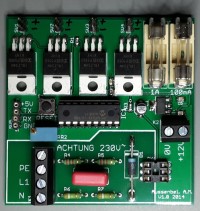Dimmbare Aussenbeleuchtung / Dimmable Outdoor Lighting [140574]

Some time ago I’ve installed in the roof over the terrace four LED spots. Unfortunately, the brightness of the four spots (2.8W each) was much too bright for us.
Note: in the updates you'll find a new schematic and PCB (V2.2), new versions of firmware and PC application
for the english version please scroll down...
Hallo, ich möchte euch hier gerne mein Projekt vorstellen.
Ich habe vor einiger Zeit auf der Terrasse 4 LED Spots in den Dachkasten eingebaut, leider mussten wir dann feststellen, dass die 4 Spots (je 2,8W) viel zu hell waren. Aus diesem Grund wurden die LED’s auch so gut wie nie angeschaltet (wer sitzt schon abends mit einer Sonnenbrille auf der Terrasse). Irgendwann kam mir dann die Idee, die LED’s zu dimmen (in der Anleitung steht zwar nicht dimmbar), aber da die LED‘s 12VDC benötigen sieht die Chance gar nicht so schlecht aus. Dann habe ich schnell das Steckboard raus gekramt und ein paar Bauteile zusammen gesucht. Anschließend habe ich eine Schaltung zusammen gesteckt. Ich habe mich beim Versuch für ein µC entschieden, da dies die schnellste Variante war, die LED’s mit PWM anzusteuern. Und siehe da die LED’s lassen sich doch dimmen. Während den Experimenten kam mir dann die Idee, die Schaltung so zu ändern das der Dämmerungsschalter die Schaltung mit 12VDC versorgt und die LED’s mit einem Tastgrad von 10% leuchten. Wenn dann ein Bewegungsmelder eine Bewegung erkennt wird (fast) stufenlos auf 50% hoch gedimmt und bei verlassen wieder zurück auf 10%. Beide Werte sind individuell über UART einstellbar und bei Versuchen hat sich herausgestellt das 10% und 50% optimale Werte bei unseren LED’s sind. Jetzt haben nicht nur die LED’s die optimale Helligkeit, es wird auch noch Energie gespart. Wie schon beschrieben, schaltet der Dämmerungsschalter die 230VAC für das Schaltnetzteil und die 12VDC versorgen jetzt die Schaltung und die LED’s. Die 12VDC wird dann auf 5VDC (IC2) für den Logikteil herunter geregelt. Der µC arbeitet mit einer Frequenz von 200kHz und erzeugt damit eine Frequenz von 150Hz für die PWM. Benutzt wird nur ein PWM Ausgang der die 4 Logik-Level MOSFET’s ansteuert (ein MOSFET pro Lampe). Das Programm wurde mit „mikroBasic PRO for PIC“ von „MikroElektronika“ entwickelt. Die 230VAC vom Bewegungsmelder werden galvanisch über den OK1 (Optokoppler 4N28) getrennt und auf einen Eingang vom µC gelegt.
Das Programm für den µC ist so klein, dass es mit der Demo-Software von MikroElektronika bearbeitet werden kann. Zusätzlich habe ich mit "Visual Basic Express" eine Software entwickelt mit der man über UART die Werte übermitteln kann.
Optimierungen:
Die Schaltung ist so ausgelegt, dass ich ein Großteil der vorhandenen Bauelemente verwenden konnte. Optimaler wäre sicherlich der Optokoppler PC814, anstelle vom verwendeten 4N28, dann hätte man sich die Diode D1 sparen können (siehe http://www.mikrocontroller.net/articles/230V). Für den verwendeten µC PIC16F628 hätte auch ein PIC12F gereicht bzw. wäre dieser Zeitgemäßer. Für die MOSFET T1 – T4 hätte man auch SMD Varianten nehmen können. Alles zusammen hätte für ein wesentlich kleineres LP-Layout geführt. Ich habe die Leiterplatte so entworfen, dass diese in eine Aufputz-Abzweigdose passt (in meinem Fall 85x85mm), aber beim klemmen habe ich gemerkt, dass ein paar mm mehr Luft besser gewesen wären.
_____________________________________
EDIT:
_____________________________________
EDIT:
_____________________________________
EDIT 03/31/2015:
Hi i changed the firmware for the µC and i have a problem now.
I removed the "delays" (for dimming time) and added a simple addition for this function. This is working well, but i have a problem to setup the values via uart.
I'm sending a data string from the windows programm to the µC via uart and the µC receive the string but chronology the is wrong.
I don't understand why because i use a uart receive interrupt.
This is a example for the data string:
start_byte | percent_low | percent_high | dim_up | dim_dn | end_byte
250 | 10 | 50 | 10 | 20 | 200
The new windows program and µC firmware is added below.
I hope someone understand my problem and can help me.
with regards
EDIT 03/31/2015:
_____________________________________
µC project and Win Software added
µC project and Win Software added 03/31/2015



Updates van de auteur